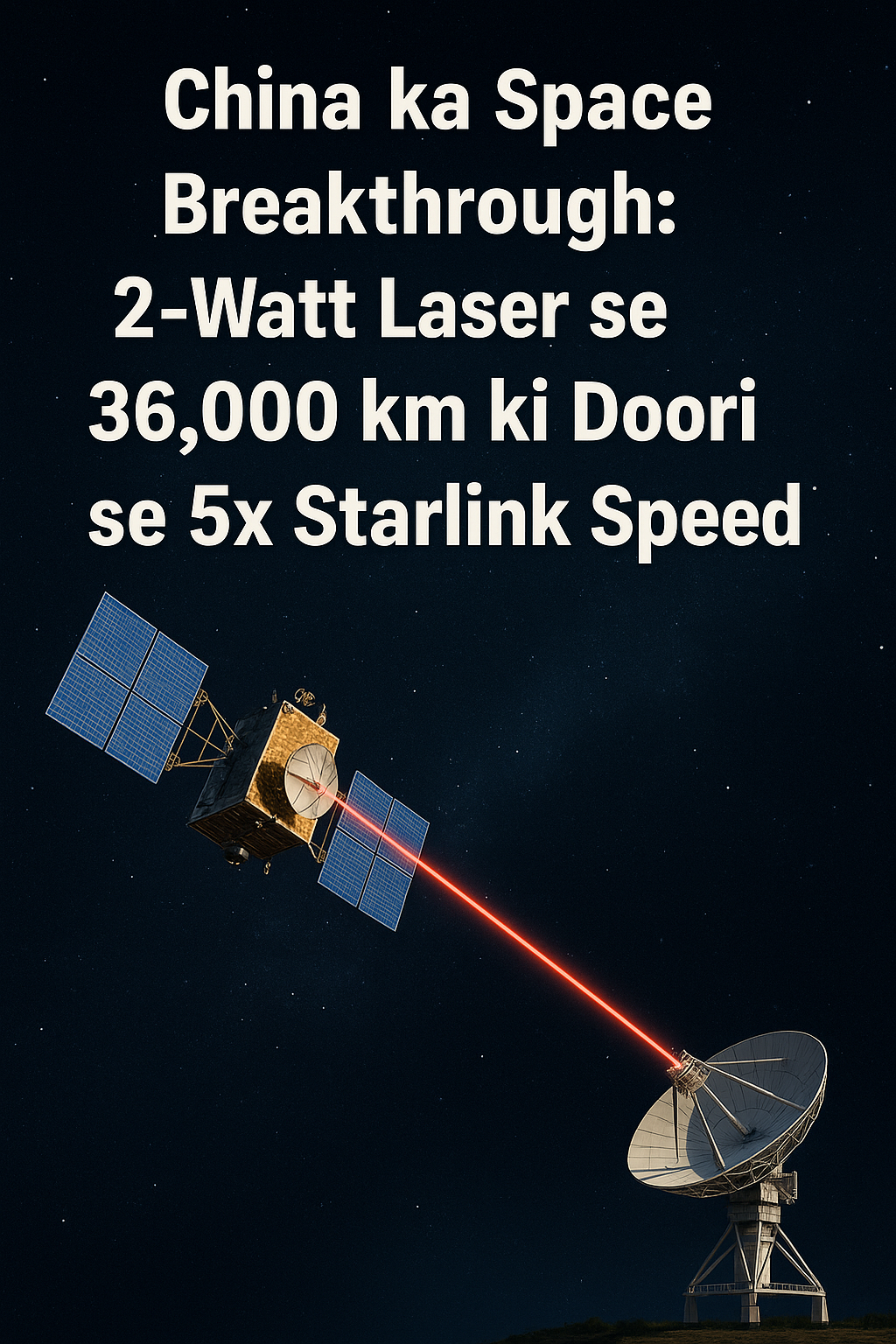China’s Space Breakthrough: 5x Starlink Speed from 2-Watt Laser to 36,000 km range
Introduction: New Revolution in Space Technology China has shown another amazing space technology. This time it is not just about launching a rocket, but about a communication breakthrough that can transform future internet systems. Chinese scientists have achieved a speed of 100 Gbps by transmitting data from geostationary orbit to Earth using a 2-watt laser from an experimental satellite – which is 5 times faster than Elon Musk’s Starlink system.
This is a scientific and technological achievement that is surprising space and telecom experts around the world. In this article we will learn how this is possible, what is the science behind it, and what impact it can have on the future.
What is this mission? Chinese researchers placed a satellite in a geostationary orbit at a height of 36,000 kilometers. This satellite transmitted data to the ground station using just a 2-watt optical laser – without any loss, without any distortion. This experiment achieved a speed of 100 Gbps (Gigabits per second), which is far ahead of any commercial satellite internet service so far.
This satellite was designed by researchers from the Chinese Academy of Sciences. Its purpose was to test new possibilities of optical communication – and they did a great job.
How does Optical Laser Communication work? Traditional satellites use radio frequency (RF) waves. But they have limited bandwidth and a lot of interference.
Optical laser communication is an advanced technique that uses high-frequency laser beams. Laser beams are narrow, have no interference, and are focused — so they can transmit a lot of data very accurately.
Key Features of Laser Communication:
High Data Rate: Speed up to 100 Gbps possible.Less Power Use: Just 2-watt laser did the job.
Secure Transmission: Laser has a narrow beam, which is difficult to hack.
No RF Interference: This reduces the load on the crowded radio spectrum.
Starlink vs Chinese Optical Satellite
Feature Starlink Chinese Laser Satellite
Orbit Low Earth Orbit (~550 km) Geostationary Orbit (36,000 km)
Data Speed ~20 Gbps per satellite 100 Gbps (5x faster)
Power Requirement Several hundred watts Only 2 watts
Communication Type Radio Frequency (RF) Optical Laser
Interference High Very Low
Cost & Scalability High cost of constellations Fewer satellites needed
This comparison clearly shows that China has demonstrated technological superiority, at least in terms of raw data speed and efficiency.
What does 36,000 km distance mean?Satellites on a Geostationary orbit (GEO) always appear fixed at one place above the Earth. The specialty of this orbit is that it is ideal for long-range communication. But till now it was difficult to provide high-speed internet from this orbit – because the distance is too much and latency also increases.
But this laser-based technology has removed all these limitations.
What does this mean for the future?
1. Global High-Speed Internet: If this technology is scaled, then faster internet than 5G can be provided in remote areas of the world without any infrastructure.
2. Military & Surveillance Applications: Laser-based secure communication is ideal for military missions. This can improve encryption and data safety.
3. Reduced Satellite Constellations: While Starlink requires thousands of satellites for internet coverage, this technique of China can work with only a few powerful GEO satellites.
4. Space-to-Space Communication: This technology can also be used for high-speed communications between satellites — such as Moon missions, Mars bases, or deep-space probes.
What are the challenges?
Weather Dependency: Laser signals can be blocked by clouds and rain. This requires adaptive optics or alternate backup systems.
Precision Required: Laser beams are very narrow — so both the satellite and the ground station need ultra-precise alignment.
Scalability: This was an experimental mission. Mass production and implementation will take time and investment.
International Competition: US, Europe, Japan are all working on this technology. Space-based laser internet has become a new race.
People from the forefront of science. This breakthrough was achieved by researchers from the Xi’an Institute of Optics and Precision Mechanics of the Chinese Academy of Sciences. They say that this is the “world’s highest data rate communication from GEO satellite”.
A special optical terminal was installed on the satellite, which had a photon receiver, tracking system, and ultra-low noise detectors.
Global Reactions
NASA: There has been no official response so far, but according to insiders, NASA is closely monitoring this development.
Elon Musk / SpaceX: Starlink is still expanding its LEO network, but SpaceX is also interested in optical communication.
India (ISRO): ISRO is also working in the field of optical communication, but nothing like this has happened at the commercial level yet.
Will this Internet reach our Smartphones? Not now, but definitely in the future. If laser communication is linked to ground base stations and optical-to-RF conversion systems are developed, then laser-based Internet can reach your smartphone directly – with lightning-fast speed.
Cold War 2.0 in Space? This mission of China is not just a scientific breakthrough, but also a geopolitical signal. Space technology has now become a battlefield of a new cold war – and laser internet can be its powerful weapon.
Conclusion: A New Era Begins China has shown a glimpse of a futuristic door where space-based laser internet will always be available — ultra-fast, secure, and based on low-power. This is not just a scientific experiment, but the starting point of a new revolution.Just as fiber optics transformed the telecom world in the 90s, laser satellite communication can take the space and internet industry into a new era.
Disclaimer: This article is written for informational and educational purposes only. The facts, figures, and technology-related claims mentioned in it are based on publicly available reports, research papers, and news sources. We are not affiliated with any government agency, private company (like SpaceX or Starlink), or Chinese organization. The comparisons made in the article are made with neutral and informational intent. Please do additional research at your own level for any financial, technical, or political decision.







Post Comment